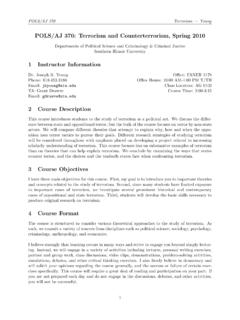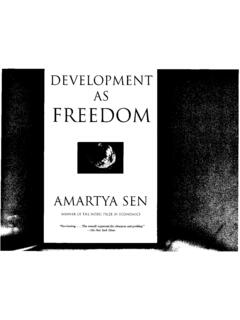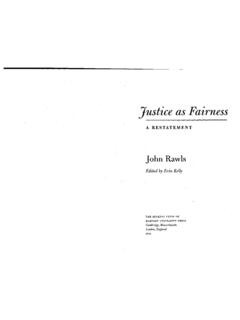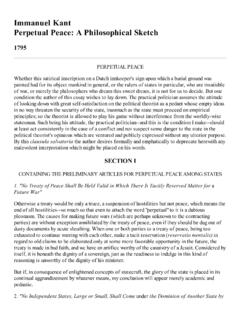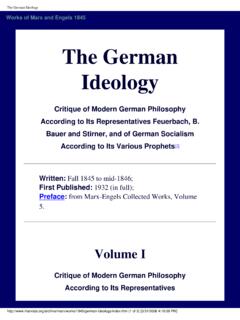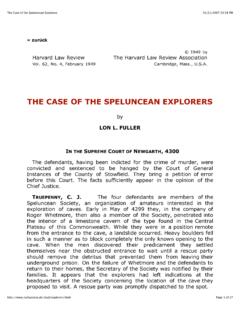Transcription of THE CONCEPT OF LAW - American University
1 THE CONCEPT OF LAW SECOND EDITION BY With a Postscript edited by Penelope A. Bulloch and Joseph Raz CLARENDON PRESS OXFORD Oxford University Press, Walton Street, Oxford ox2 6oP Oxford New York Athens Auckland Bangkok Bombay Calcutta Cape Town Dares Salaam Delhi Florence. Hong Kong istanbul Karachi Kuala Lumpur Madras Madrid Melbourne Mexico City Nairobi Paris Singapore Taipei Tokyo Toronto and associated companies in Berlin Ibadan Oxford is a trade mark of Oxford University Press Published in the United States by Oxford University Press Inc., New York Oxford University Press 1961 First edition published 1961 Second edition published 1994 (with a new Postscript) All rights reserved. No part of this publication may be reproduced, stored in a retrieval .rystem, or transmitted, in a'!)' form or by a'!)' means, without the prior permission in writing of Oxford University Press. Within the UK, exceptions are allowed in respect of a'!)' fair dealing for the purpose of research or private stut!
2 J, or criticism or review, as permitted under the Copyright, Designs and Patents Act, 1988, or in the case of reprographic reproduction in accordance with the terms of the licences issued by the Copyright Licensing Agen0'. Enquiries concerning reproduction outside these terms and in other countries should be sent to the Rights Department, Oxford University Press, at the address above This book is sold subject to the condition that it shall not, by wqy of trade or otherwise, be lent, re-sold, hired out or otherwise circulated without the publisher's prior consent in any form of binding or cover other than that in which it is published and without a similar condition including this condition being imposed on the subsequent purchaser British Library Cataloguing in Publication Data Data available Library of congress Cataloging in Publication Data Data available 0-19-8'J6I22-8 5 7 9 IO 8 6 Printed in Great Britain on acidjree paper by Biddies Ltd., Guildford and King's Lynn PREFACE MY aim in this book has been to further the understanding of law, coercion, and morality as different but related social phenomena.
3 Though it is primarily designed for the student of jurisprudence, I hope it may also be of use to those whose chief interests are in moral or political philosophy, or in so-ciology, rather than in law. The lawyer will regard the book as an essay in analytical jurisprudence, for it is concerned with the clarification of the general framework oflegal thought, rather than with the criticism of law or legal policy. More-over, at many points, I have raised questions which may well be said to be about the meanings of words. Thus I have considered: how 'being obliged' differs from 'having an obli-gation'; how the statement that a rule is a valid rule of law differs from a prediction of the behaviour of officials; what is meant by the assertion that a social group observes a rule and how this differs from and resembles the assertion that its members habitually do certain things. Indeed, one of the central themes of the book is that neither law nor any other form of social structure can be understood without an appre-ciation of certain crucial distinctions between two different kinds of statement, which I have called 'internal' and 'exter-nal' and which can both be made whenever social rules are observed.
4 Notwithstanding its concern with analysis the book may also be regarded as an essay in descriptive sociology; for the suggestion that inquiries into the meanings of words merely throw light on words is false. Many important distinctions, which are not immediately obvious, between types of social situation or relationships may best be brought to light by an examination of the standard uses of the relevant expressions and of the way in which these depend on a social context, itself often left unstated. In this field of study it is particularly true that we may use, as Professor J. L. Austin said, 'a sharp-ened awareness of words to sharpen our perception of the phenomena'. vi PREFACE I am heavily and obviously indebted to other writers; indeed much of the book is concerned with the deficiencies of a simple model of a legal system, constructed along the lines of Austin's imperative theory. But in the text the reader will find very few references to other writers and very few foot-notes.
5 Instead, he will find at the end of the book extensive notes designed to be read after each chapter; here the views expressed in the text are related to those of my predecessors and contemporaries, and suggestions are made as to the way in which the argument may be further pursued in their writ-ings. I have taken this course, partly because the argument of the book is a continuous one; which comparison with other theories would interrupt. But I have also had a pedagogic aim: I hope that this arrangement may discourage the belief that a book on legal theory is primarily a book from which one learns what other books contain. So long as this belief is held by those who write, little progress will be made in the subject; and so long as it is held by those who read, the educational value of the subject must remain very small. I have been indebted for too long to too many friends to be capable now of identifying all my obligations. But I have a special debt to acknowledge to Mr A.
6 M. Honore whose detailed criticisms exposed many confusions of thought and infelicities of style. These I have tried to eliminate, but I fear that much is left of which he would disapprove. I owe to conversations with Mr G. A. Paul anything of value in the political philosophy of this book and in its reinterpretation of natural law, and I have to thank him for reading the proofs. I am also most grateful to Dr Rupert Cross and Mr P. F. Strawson, who read the text, for their beneficial advice and criticism. H. HART EDITORS' NOTE WITHIN a few years of its publication The CONCEPT Of Law transformed the way jurisprudence was understood and stud-ied in the English-speaking world and beyond. Its enormous impact led to a multitude of publications discussing the book and its doctrines, and not only in the context of legal theory, but in political and moral philosophy too. For many years Hart had it in mind to add a chapter to Tlze CONCEPT if Law. He did not wish to tinker with the text whose influence has been so great, and in accordance with his wishes it is here published unchanged, except for minor cor-rections.
7 But he wanted to respond to the many discussions of the book, defending his position against those who miscon-strued it, refuting unfounded criticism, and-of equal im-portance in his eyes-conceding the force of justified criticism and suggesting ways of adjusting the book's doctrines to meet those points. That the new chapter, first thought of as a preface, but finally as a postscript, was unfinished at the time of his death was due only in part to his meticulous perfec-tionism. It was also due to persisting doubts about the wis-dom of the project, and a nagging uncertainty whether he could do justice to the vigour and insight of the theses of the book as originally conceived. Nevertheless, and with many interruptions, he persisted with work on the postscript and at the time of his death the first of the two intended sections was nearly complete. When J enifer Hart asked us to look at the drafts and decide whether there was anything publishable there our foremost thought was not to let anything be published that Hart would not have been happy with.
8 We were, therefore, delighted to discover that for the most part the first section of the postscript was in such a finished state. We found only hand-written notes intended for the second section, and they were too fragmentary and inchoate to be publishable. In con-trast the first section existed in several versions, having been typed, revised, retyped, and rerevised. Even the most recent version was obviously not thought by him to be in a final Vlll EDITORS' NOTE state. There are numerous alterations in pencil and Biro. Moreover, Hart did not discard earlier versions, but seems to have continued to work on whichever version was to hand. While this made the editorial task more difficult, the changes introduced over the last two years were mostly changes of stylistic nuance, which itself indicated that he was essentially satisfied with the text as it was. Our task was to compare the alternative versions, and where they did not match establish whether segments of text which appeared in only one of them were missing from the others because he discarded them, or because he never had one version incorporating all the emendations.
9 The published text includes all the emendations which were not discarded by Hart, and which appear in versions of the text that he con-tinued to revise. At times the text itself was incoherent. Often this must have been the result of a misreading of a manu-script by the typist, whose mistakes Hart did not always notice. At other times it was no doubt due to the natural way in which sentences get mangled in the course of composition, to be sorted out at the final drafting, which he did not live to do. In these cases we tried to restore the original text, or to re-capture, with minimum intervention, Hart's thought. One special problem was presented by Section 6 (on discretion). We found two versions of its opening paragraph, one in a copy which ended at that point, and another in a copy con-taining the rest of the section. As the truncated version was in a copy incorporating many of his most recent revisions, and was never discarded by him, and as it is consonant with his general discussion in the postscript, we decided to allow both versions to be published, the one which was not contin-ued appearing in an endnote.
10 Hart never had the notes, mostly references, typed. He had a hand-written version of the notes, the cues for which were most easily traced in the earliest typed copy of the main text. Later he occasionally added references in marginal comments, but for the most part these were incomplete, sometimes indi-cating no more than the need to trace the reference. Timothy Endicott has checked all the references, traced all that were incomplete, and added references where Hart quoted Dworkin or closely paraphrased him without indicating a source. EDITORS' NOTE lX Endicott also corrected the text where the quotations were inaccurate. In the course of this work, which involved exten-sive research and resourcefulness, he has also suggested several corrections to the main text, in line with the editorial guide-lines set out above, which we gratefully incorporated. There is no doubt in our mind that given the opportunity Hart would have further polished and improved the text before publishing it.



